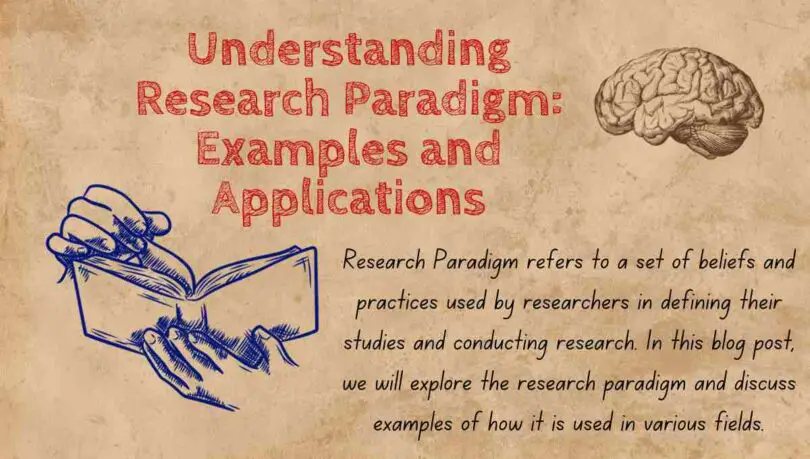A research paradigm is a set of ideas, beliefs, or understandings within which theories and practices. It is a fundamental way of understanding and approaching research in a particular field. It provides a framework for guiding research questions, hypotheses, and methods.
In each paradigm, researchers have different assumptions about the nature of reality, and there are different techniques used to gather and analyze data. It is important to understand the appropriate paradigm for a particular research question to ensure that the research is conducted effectively.

This article will provide an overview of research paradigms and offer examples that can be used to illustrate how different types of research are conducted. It will also discuss the advantages and disadvantages of each approach and offer some tips to help researchers decide which approach is most appropriate for their research. The article will conclude with guidance for researchers to consider when selecting a research paradigm.
And we will conclude on these four Types of Research Paradigms
- Positivist Research Paradigm
- Interpretivist Research Paradigm
- Pragmatist Reserch Paradigm
- Criticial Theory or Action Research
We will also discuss the following three foundations oaf a research Paradigm
- Onotology
- Epistomology
- Methodology
What Is a Paradigm in Research?
Now that we know the purpose of research, it is important to understand the concept of a research paradigm or a paradigm in research. A research paradigm is a set of assumptions and beliefs that guide research. It is a framework that outlines the theories and methods used to conduct research. It also provides the researcher with a set of rules and guidelines for interpreting the data collected.
A research paradigm is a belief system that shapes how research is conducted and how the results are interpreted. It is based on the underlying philosophy and values that guide the researcher. For example, a researcher may be guided by scientific methodology, which is based on the principles of empiricism. This type of research paradigm focuses on objectivity and the use of scientific methods to collect and analyze data. On the other hand, an interpretivist research paradigm may be based on the idea that knowledge is constructed through the interpretation of experience and that reality is socially constructed.
The choice of research paradigm is an important decision for any researcher as it will influence the entire research process. It will determine the types of questions that are asked, the methods used to collect data, the way the data is analyzed, and the way the findings are interpreted. The researcher should be aware of the implications of their chosen research paradigm and the potential biases that it might introduce.
Furthermore, it is important to note that research paradigms are not mutually exclusive. Research can be conducted from more than one perspective. Researchers may use a combination of different paradigms in order to gain a more comprehensive understanding of their research topic.
The 3 Pillors (Foundations) of a Research Paradigms?
Research is composed of three foundations:

- Ontology
- Epistemology
- Methodology
Ontology is simply the study of being, or existence – what is and isn’t. It is the foundation of any research, asking the big questions to determine what can be studied. Epistemology is the study of how we know, or the theory of knowledge. It is the examination of how knowledge is acquired, and how certain conclusions can be made. Methodology is the study of methods used to conduct research.
Having discussed the definition and purpose of a research paradigm, let’s take a deeper dive into one of the three core elements:
Ontology
Ontology is the branch of philosophy that examines the nature of being and the origin of existence. In research, ontology refers to the researcher’s beliefs and assumptions about the nature of reality, including the relationship between the researcher and the phenomenon being studied. More specifically, it considers whether the world is composed of discrete entities or if it is an interconnected whole.
In quantitative studies, ontology typically assumes that the world is composed of separate entities that can be measured and studied objectively and that there are universally accepted truths. This view is often associated with positivism, which seeks to explain the world through objective facts and cause and effect relationships.
In contrast, qualitative studies usually assume that the world is composed of interconnected parts, and that reality is seen through the lens of the researcher’s own experiences. This is associated with constructivism, which views reality as a shared construction based on individual perspectives and values.
The ontology that a researcher adopts heavily influences the method they use to study the phenomenon, as well as the results and conclusions they come to.
Epistemology
One way to consider the various paradigms of research is to think of them as distinct lenses, each providing a unique perspective. To move from the previous section’s discussion of research paradigms, we’ll now explore one of the core aspects of these paradigms—epistemology.
Epistemology is the branch of philosophy that examines the nature of knowledge and how it is acquired. It is related to the ideas of ontology, which looks at the nature of reality, and methodology, which focuses on the study and practice of research.
At the core of epistemology lies the fundamental question of how we come to know what we know.
Do we rely on our senses to perceive the world around us?
Do we rely on intuition, reason, or evidence?
Or, do we trust in some form of “higher power” to provide us with knowledge?
Epistemology is closely intertwined with the notion of truth, as it is the study of how we arrive at the truth. There are several different approaches to epistemology, each of which has its own set of assumptions and beliefs.
Methodology
Having discussed the two core concepts of research paradigms, Ontology and Epistemology, let’s move on to the third core concept of Methodology. Methodology is the process used to study, investigate, and analyze a phenomenon. It is the set of principles, techniques, and tools used to collect and analyze data related to a specific problem. In essence, it is the method used to answer research questions.
Methodology can be divided into two distinct types: qualitative and quantitative. Qualitative research is an exploratory approach to data collection that is based on the perspectives, experiences, and interpretations of participants. It often includes in-depth interviews, focus groups, and field observations. On the other hand, quantitative research involves the use of numerical data to gain insights into the studied phenomenon. It includes surveys, experiments, and statistical analysis.
The choice of methodology in a research project depends on a number of factors, including the research question, the type of data collected, the purpose of the research, and the resources available. It is important to consider all these factors before selecting the appropriate methodology.
Ultimately, the selection of the right methodology will ensure that the research project is successful.
What Is the Purpose of a Research Paradigm?
The three pillars of a research paradigm provide a useful lens for researchers to analyze and interpret their work, but what is the purpose of a research paradigm?
To understand this, it is important to first understand the concept of paradigms in a broader sense. A paradigm is a set of assumptions, concepts, values, and practices that define the way a particular field of study approaches its subject. It provides a framework for interpreting the findings of a study, and the goal of a research paradigm is to create a universal framework that can be used to evaluate research in a particular field.
In the field of research, the three paradigms of research are positivism, interpretivism, Pragmatism or Cratical Theory.
Positivism is based on the idea that reality is an objective phenomenon that can be measured and studied using the scientific method.
Interpretivism is based on the idea that reality is subjective and can be studied through the use of qualitative methods such as interviews and case studies.
Pragmatism is abased on the assumption of change and practiability that everything is changinging and nothing is permanant.
Pragmatism emphasizes the principle that the usefulness, workability, and practicality of ideas, policies, and proposals are the criteria for determining their merit. This paradigm focuses on practical outcomes and emphasizes that an idea’s usefulness or practicality should be the method for measuring its merit.
The purpose of a research paradigm is to create a shared understanding of how to interpret the findings of research. By creating a shared understanding of what constitutes valid research, researchers can better evaluate the evidence presented in a study and draw conclusions that are meaningful and applicable to their own field of study. Through the use of a research paradigm, researchers can also identify patterns and trends in data that may not have been noticed before, allowing them to better understand the underlying causes of certain phenomena.
Having discussed the purpose of a research paradigm, let us now delve into the specifics of the different paradigms and their common examples. We start with the positivist paradigm.
Types of research paradigms
There are different Research paradigms but the best 2 research paradigms are The Positivist Paradigm states that everything is measurable in the numerical value and The Interpretivism or Constructivism Paradigm states that everything is not possible to be measured in the numerical value
The Positivist Paradigm is based on the belief that the world is knowable and that empirical knowledge can be acquired through logical deduction and the use of mathematics. It views the social world as an entity that can be studied objectively and quantitatively.
The Interpretivism or Constructivism Paradigm is based on the belief that the social world is constructed through the experiences of individuals, and that it can only be studied qualitatively.
Positivist Paradigm
The positivist paradigm is rooted in the positivist philosophy, which states that the only valid knowledge is based on facts and evidence that can be observed and measured. This paradigm focuses on cause and effect relationships and utilizes quantitative methods such as experiments and surveys to generate data for analysis. It generally takes the view that reality is objective and can be studied and explained.
When it comes to the positivist paradigm, the main emphasis is on objectivity. This is why the methods used in this paradigm are usually concerned with measurement, quantification and the production of numerical data. This empirical data is then used to identify and explain causal relationships in the physical world. It is also used to test hypotheses in a scientific manner.
Some common examples of research within the positivist paradigm include medical trials, economic experiments and psychological studies. These studies use methods such as surveys, questionnaires and experiments to generate data, which is then analyzed and used to draw conclusions about the physical world. Such studies also often involve controls and randomization to ensure accuracy and validity.
Interpretivist or Constructivist Paradigm
The Interpretivist or constructivist paradigm is another belief system that often influences research. It is based on the idea that reality is socially constructed by individuals and therefore cannot be described objectively. This perspective focuses on the subjective meanings that people have, and how those meanings are constructed. It is rooted in the notion that people develop their understanding of the world through their experiences and beliefs.
This research paradigm allows for a more natural and open-ended approach to research. It encourages researchers to interact with and observe people in their natural environment rather than attempting to measure and control variables in a laboratory setting. It also allows for multiple interpretations of data, since it is based on the idea that people can understand phenomena differently due to their individual backgrounds and experiences.
Interpretivist or constructivist research often includes interviews, focus groups, and participant observation. The goal is to gain insight into the way people think, their beliefs, and how they interact with the world around them. This type of research is valuable for understanding the social context of an issue and developing an understanding of how people make sense of their world.
Pragmatist Paradigm
Having discussed the purpose of a research paradigm, let’s now turn our attention to examples of different research paradigms. Specifically, we’ll explore Pragmatist Paradigm, which is based on the concept of “problem-solving.” This approach to research seeks to understand the ways that different individuals and organizations cope with their day-to-day challenges. This paradigm focuses on the application of knowledge and the creation of tools and techniques to address problems.
The basic idea behind Pragmatism Paradigm is that the value of knowledge lies in its practical application. Thus, the goal is to identify solutions that are effective in addressing the problems that people face. This approach involves the use of empirical data, such as interviews, surveys, and experiments, to identify and analyze the best solutions to a given problem.
The Pragmatism Paradigm is often used in fields such as psychology, social work, and business. For instance, this paradigm has been used to understand how organizations can improve the customer experience, identify patterns of employee performance, and develop effective strategies for marketing and advertising.
Another example of Pragmatism Paradigm is its use in healthcare.
Postpositivist Paradigm
Building on the previous section’s discussion of the purpose of a research paradigm, the postpositivism paradigm is an example of a research paradigm that seeks to bridge the gap between positivism and interpretivism. Postpositivism holds that although reality is objective, it can only be understood through individual interpretations. This paradigm acknowledges the subjective element of research and recognizes that personal values, experiences, and beliefs influence the research process and results. It is important to note that postpositivism doesn’t completely reject the principles of positivism, but instead seeks to provide a more comprehensive approach to research that takes into account the subjective elements of the research process.
Postpositivism holds that although reality is objective, it is incomplete and shaped by personal interpretations. It also acknowledges the importance of understanding the context of any research project and encourages researchers to consider the implications of their findings. As such, postpositivism allows researchers to maintain objectivity in their research while also recognizing the importance of subjective elements.
The postpositivism paradigm is often used in research that seeks to understand complex human behaviors and social phenomena. It is particularly useful in fields such as anthropology, sociology, and psychology, where researchers need to take into account the subjective elements of their research in order to understand their findings.
Common Examples of Research Paradigms
Now that we know the purpose of research paradigms, let’s take a closer look at some common examples. Quantitative research is a data-driven approach that typically uses surveys, polls, and questionnaires to collect numerical data. This type of research is used in areas such as sociology, psychology, education, economics, and public health.
Qualitative research is an approach that uses non-quantitative methods to gather data. This type of research is often used in the social sciences to gain deeper insight into a topic. It usually involves using open-ended questions and observation to gain an understanding of a phenomenon. Examples of qualitative research include interviews, focus groups, case studies, and ethnographies.
Mixed methods research is an approach that combines both quantitative and qualitative methods to gain a more comprehensive understanding of a research topic. This approach is often used when qualitative data are used to supplement the quantitative data or when quantitative data are used to verify and validate the qualitative findings. Examples of mixed methods research include surveys with follow-up interviews and observations with pre- and post-tests.
Summary
Research paradigms are an essential component in any research or scientific study. Through them, research questions are formed, hypotheses are developed, and data are collected and analyzed. The three paradigms of research, including positivism, interpretivism, and critical theory, each have unique methods and approaches that are important to understand in order to best inform research. Understanding the various research paradigms is essential to produce sound and meaningful results that will contribute to knowledge in a field.
In conclusion, research paradigms provide a framework for understanding the complex nature of research and help to produce meaningful and reliable results. They are a valuable tool for any researcher and essential for successful scientific inquiry. With the right approach and understanding of the different paradigms, researchers can make significant contributions to their field of study.







[…] inability to capture the complexity of human behavior, and its potential for ethically questionable research practices, should be considered when using the positivist research paradigm. By understanding the implications of the positivist research paradigm, researchers can use it to […]
[…] As such, the interpretations and conclusions drawn from research conducted within the Interpretive Paradigm are shaped not only by the data but also by the researcher’s subjective biases, perspectives, […]
[…] research philosophy and research Paradigm also encapsulates the nature of the knowledge that you seek to or expect to obtain by undertaking […]
[…] as a research paradigm, diverges from the contentious metaphysical debates surrounding truth and reality. Instead, it […]
[…] frameworks is essential for researchers to effectively design and conduct their studies. The paradigm provides the overarching philosophical foundation that informs the researcher’s perspective and approach, while the conceptual framework offers a specific structure for organizing […]
[…] article deals with Critical Theory but once again you may need to know about the research paradigm so here the basics are […]
[…] Interpretivist Research Paradigm […]